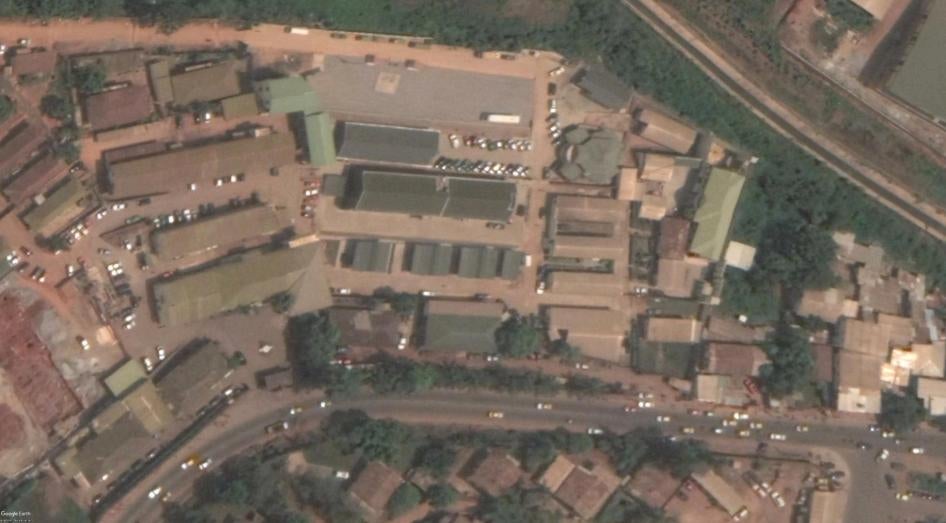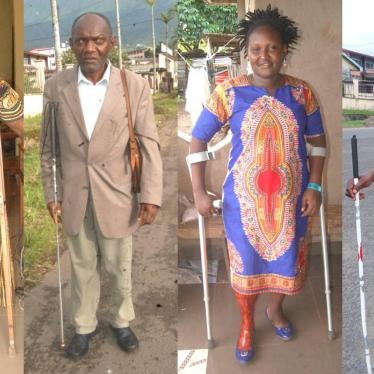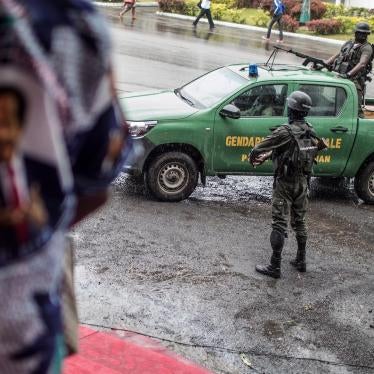(Nairobi) – Cameroonian authorities held over 100 detainees incommunicado and tortured many of them in a detention facility in Yaoundé, Cameroon’s capital, from July 23 to August 4, 2019.
The detainees were transferred to the facility, the State Defense Secretariat (Secrétariat d’État à la défense, SED), the morning after inmates in Yaoundé’s Central Prison rioted on July 22 in protest at overcrowding, dire living conditions, and delays in their cases getting to trial. Many were in detention on suspicion of being involved with or supporting armed separatist groups operating in English-speaking regions of Cameroon. Since late 2016, a cycle of civil protests there, followed by government repression, has escalated to hostilities between government forces and armed separatist groups, resulting in over 2,000 deaths. Others included members and supporters of the opposition party Cameroon Renaissance Movement (Mouvement pour la renaissance du Cameroun, MRC).
“These credible accounts of torture and abuse out of the State Defense Secretariat are sadly not the first, but only the most recent,” said Lewis Mudge, Central Africa director at Human Rights Watch. “The security forces’ apparent belief that they are free to torture and otherwise abuse detainees is a direct consequence of the Cameroonian government turning a blind eye to reports about the abuse – but the world is watching.”
In a news release dated August 2, Communication Minister René Emmanuel Sadi confirmed that 224 prisoners were transferred from the Central Prison to police and gendarmerie units in Yaoundé for questioning but did not specify which facilities.
Human Rights Watch has established that at least 100 of the prisoners were taken to the SED. The whereabouts of the majority was unknown for almost two weeks. When an individual’s detention is followed either by a refusal to acknowledge the detention or to reveal the person’s fate or whereabouts, this constitutes an enforced disappearance, an egregious human rights violation, Human Rights Watch said. On August 3, the day after official acknowledgement of the men’s whereabouts, some lawyers were finally able to meet with some of their clients at the SED.
Human Rights Watch interviewed 14 detainees held at the SED, all of whom said they were tortured and held incommunicado during their time there, and heard credible accounts that scores more were also tortured. Human Rights Watch also spoke with family members of detainees and six lawyers who provided information about their clients and detention conditions.
A 29-year-old detainee from Kumba, South-West Region, said: “We were treated like animals; we were beaten twice a day with wooden clubs and machetes. The hygienic conditions were dreadful.”
On August 4, all prisoners who had been transferred to the SED were moved back to the Central Prison. Lawyers told Human Rights Watch that on August 6 at least 80 of the detainees who were returned to the Central Prison were charged before a Yaoundé court of first instance with “rebellion, attempted prison break, destruction of property and theft.”
Some lawyers were not permitted in the courtroom, so their clients had no representation while they were being charged. Lawyers who were able to see their clients beforehand told Human Rights Watch that their clients said they had been tortured at the SED. Some showed signs of torture, the lawyers said.
A lawyer representing eight opposition party prisoners, who were among those who reported torture, said: “I spoke to my clients on August 6 outside the courtroom. I saw horrors. They all had scars on their bodies due to the torture suffered at the SED, and injuries on their heads. They told me that they had been severely beaten at the SED at least twice, in their cells, by gendarmes and other guards using wooden clubs. They also told me that they were interrogated at gunpoint.”
Under human rights law, all forms of inhuman and degrading treatment of detainees is strictly prohibited, and Cameroonian law provides that detainees shall not be subject to any physical or mental constraints, or to torture, and that their counsel and families should be able to visit them at any time.
Human Rights Watch has previously documented the widespread use of torture and incommunicado detention at the SED, mainly of detainees suspected of ties to armed separatist groups. The prison has been used to hold people incommunicado and as a place of torture since at least 2014. Torture is pervasive across the country, in both official and unofficial detention centers.
In December 2017, the United Nations Committee Against Torture said that the government of Cameroon should ensure prompt, effective, and impartial investigations into all allegations of torture, ill-treatment, and incommunicado detention, and appropriately prosecute and punish abusers. The government has taken no action to implement the recommendation.
On August 15, Human Rights Watch sent a letter with its findings to Ferdinand Ngoh Ngoh, secretary general at the presidency, requesting a response to questions but the government did not respond.
“Cameroonian law enforcement authorities seem happy to torture without an afterthought for the repercussions,” Mudge said. “These types of reports will become more commonplace until Cameroon’s international partners stand up and press the government to take action.”
July 22 Prison Riot and Transfer to SED
According to media reports, the July 22 protests in Central Prison turned into riots as the prisoners took over parts of the prison. Human Rights Watch reviewed videos and pictures showing buildings on fire and shots fired as security forces tried to reassert control. Human Rights Watch was not able to confirm whether live ammunition was used, but other reports indicate it was.
Human Rights Watch heard credible reports that, as authorities attempted to re-establish order, they beat detainees, in particular those they suspected of being responsible for the riot.
Lawyers for MRC members and supporters said their clients believed that they were targeted for beatings, including the MRC vice president, Mamadou Mota, who has been in prison since June 1. Mota was arrested for leading protests calling for the release of the MRC president, Maurice Kamto, who had been arrested on January 30. Both Mota and Kamto are currently facing trial before the Military Court in Yaoundé.
Mota’s lawyers told Human Rights Watch that a prison guard and a gendarme beat him at the Central Prison, breaking his arm, and that he was then taken to the Security Directorate facility where he was held in solitary confinement for 12 days. He was allowed to see his lawyers four days after he arrived. As far as Human Rights Watch has been able to determine, Mota is the only detainee – among those transferred from the Central Prison to other facilities – allowed to meet with his lawyers before August 3.
After the riot was quelled, approximately 100 detainees were transferred to the SED.
A 30-year-old detainee from the North-West Region told Human Rights Watch:
At about 1:30 a.m. on July 23, the guards of the Central Prison removed us all; they said that all “Ambazonians” [Anglophones] should go. I was taken to the SED with only my shirt. I was alongside dozens of other Anglophones. We were seriously beaten up. We were brought to the underground cells with no sunlight.
Incommunicado Detention
All 14 detainees Human Rights Watch interviewed said that they were held at the SED for 12 days before being allowed to briefly speak with lawyers on August 3.
Five relatives of detainees said that they did not know where their loved ones were until August 3, and that when they had approached the SED during the previous 10 days to inquire about the detainees, they were denied access and refused any official acknowledgement that they were being held there.
The wife of an anglophone detainee who was arrested in Bamenda, South-West Region, in late 2016 and who had been held in Yaoundé’s Central Prison said:
I had not heard from him since July 23. The lawyer told me he finally saw him at the SED, but I didn’t speak to him. I was very worried, because he had already been tortured at the SED before. When I went to Kondengui [Central Prison] the day of the riot, I was denied access. I went to the SED and a guard told me that many of those transferred from the Central Prison were held in the SED. However, he would not let me in.
A lawyer for three men who were missing from July 22 to August 3 said that he was not given any information by the prison authorities and was denied access to the SED: “I went to the SED on July 24 and 25. I could not get in. The guards told me I couldn’t enter and didn’t provide any other information.”
A 41-year-old detainee from Ndu, North-West Region, said:
In the SED, nobody had access to family members. I think my family thought that I was dead. Some lawyers came the day before we were brought back to Kondengui [Central Prison]. But for 12 days, we were held in secret, with no access to the outside world. If you asked to see anyone, you would be badly beaten.
A 25-year-old man from the South-West Region said:
We did not see anyone except for the guards who would only beat and insult us for two weeks. We had no access to the outside and couldn’t call anyone; we couldn’t see our lawyers and families. It was like being in a nightmare.
Torture
All 14 detainees interviewed said that they were tortured at the SED. They said that they were beaten with various objects, including wooden sticks, planks, electric cables, machetes, and guns.
A 37-year-old man from Bamenda said gendarmes attempted to suffocate him: “The gendarmes put a piece of cloth on my nose and beat me. I was tortured like this, beaten badly several times on my legs and back.”
A lawyer representing anglophone detainees who was permitted to see his clients on August 3 said:
What I saw was unbearable. The good news was that they were not dead, but some of them were in horrible physical and psychological conditions. One had a laceration in the head and was given seven stiches with no anesthesia. Another had also several lacerations on the head and was given 12 stiches, again with no anesthesia. I saw injured detainees. We met with 80 of them after having tried to see them for 12 days. Our clients told us that they were forced at gunpoint to wear T-shirts and clothes provided by the guards at the SED, just to meet with us, because when they had been brought in and while they stayed there, they were kept naked or half-naked.
A 32-year-old anglophone detainee from Bamenda, North-West Region, said:
I was beaten, taken out of Kondengui half-naked. I was brought to the SED with other detainees, mostly Anglophones. I was held in a small cell underground with around 20 other people. The guards beat us with sticks and electric cables. I was beaten like a snake. The food and hygiene were simply deplorable.
A 26-year-old detainee from Manyu division, South-West Region, said:
The beatings started in Kondengui and continued at the SED. We were treated very badly and beaten up at least twice a day, in the morning and in the evening, with electric cables, clubs, and machetes. We slept on wet floors for two weeks. We had no access to any medical service.
As previously documented by Human Rights Watch, detention conditions at SED are appalling, with poor hygiene and sanitation and lack of appropriate medical care. Detainees also reported overcrowding, inadequate and insufficient food, and no access to fresh air.









